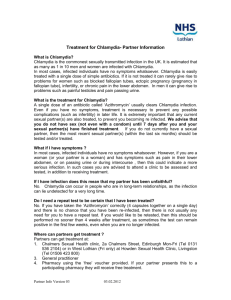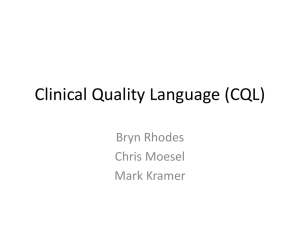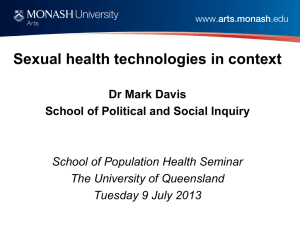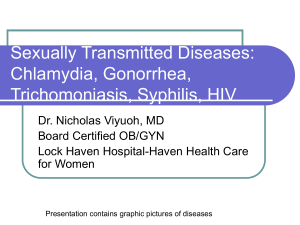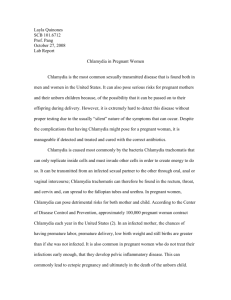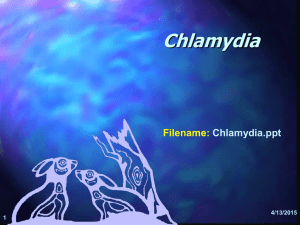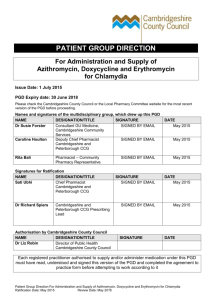Clinical Details
advertisement
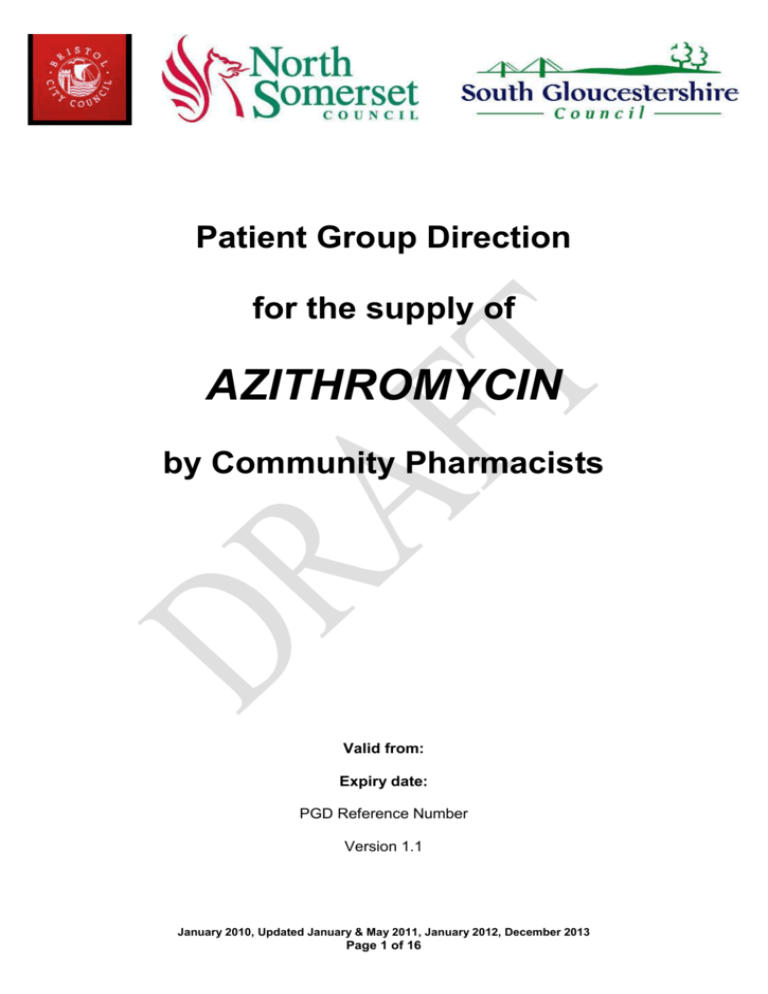
Patient Group Direction for the supply of AZITHROMYCIN by Community Pharmacists Valid from: Expiry date: PGD Reference Number Version 1.1 January 2010, Updated January & May 2011, January 2012, December 2013 Page 1 of 16 Patient Group Direction (PGD) for the supply of AZITHROMYCIN BY COMMUNITY PHARMACISTS Authorisation details: Name and Job Title Updated by Rachel Britton Senior Prescribing Advisor North Somerset CCG Reviewed by Helen Wilkinson South Gloucestershire CCG Signature Date This patient group direction has been approved on behalf of Bristol Council by: Name and Job Title Signature Date Doctor Pharmacist Governance Lead This patient group direction has been approved on behalf of North Somerset Council by: Name and Job Title Doctor Pharmacist Public Health Representative Signature Date Dr Mary Backhouse Chief Clinical Officer NHS North Somerset CCG Debbie Campbell Head of Medicines Management Becky Pollard Director of Public Health North Somerset Council This patient group direction has been approved on behalf of South Gloucestershire Council by: Name and Job Title Signature January 2010, Updated January & May 2011, January 2012, December 2013 Page 2 of 16 Date Doctor Pharmacist Mel Green Head of Medicines Management Public Health Representative Patient Group Direction (PGD) for the supply of Azithromycin This patient group direction (PGD) is a specific written instruction for the supply of azithromycin to groups of patients within the areas covered by Bristol City Council, North Somerset Council and South Gloucestershire Council. The majority of clinical care should be provided on an individual basis. The supply of medicines under Patient Group Directions should be reserved for those limited situations where this offers an advantage for patient care (without compromising patient safety) and where it is consistent with appropriate professional relationships and accountability. Staff Characteristics Pharmacist registered with the GPhC who has undertaken relevant training as specified by NHS Bristol Has undertaken appropriate training to carry out clinical assessment of client who requires treatment according to the indications listed in the PGD, including use of the Fraser guidelines. Has undertaken appropriate training for working under patient group directions for the supply and administration of medicines Has undertaken training appropriate to this PGD in line with current requirements of the BNSSG Contraception & Sexual Health Services Guidelines Group Pharmacist should be familiar with the information on azithromycin in the current BNF All registered Pharmacists are professionally accountable for their practice in accordance with the GPhC. In the exercise of professional accountability there is a requirement to maintain and improve their professional knowledge and competence. THE PHARMACIST MUST BE AUTHORISED BY NAME, UNDER THE CURRENT VERSION OF THIS PGD January 2010, Updated January & May 2011, January 2012, December 2013 Page 3 of 16 BEFORE WORKING ACCORDING TO IT Clinical Details Indication Inclusion criteria Male and female clients who have a positive genital Chlamydia result following screening by the Avon Chlamydia screening programme. Sexual contact of a client with a positive genital Chlamydia result diagnosed through the Chlamydia screening programme. Male or female client with a diagnosis of uncomplicated Chlamydia or a sexual contact requiring treatment. (The pharmacy will receive confirmation from the local Chlamydia screening office that the client tested positive for Chlamydia.) Age – adults and young people aged 13 years and over, up to and including those aged 24 years* (*In exceptional circumstances, the pharmacist may use their professional judgement to supply to a patient aged 25 years or above provided the patient meets the PGD requirements and has been referred by the Avon Chlamydia Screening Programme) Young persons under the age of 16 years should be competent under the Lord Fraser guidelines (or have treatment consent from a carer with parental responsibility) In a female client the risk of pregnancy is nil or negligible1. To re-treat client who has vomited within 2 hours of taking the azithromycin for the treatment of Chlamydia. 1 Recent publications from the FFPRHC CEU refer to being “Reasonably certain the woman is not pregnant” and define this as “has not had intercourse since the last normal menses; has been correctly and consistently using a reliable method of contraception; is within the first 7 days of the onset of a normal menstrual period; is within 4 weeks postpartum for non-lactating women; is within the first 7 days post-abortion or miscarriage; is fully or nearly fully breastfeeding, amenorrhoeic and <6 months postpartum. Pregnancy testing if available adds weight to the exclusion of pregnancy but only if ≥ 3 weeks since the last episode of unprotected sexual intercourse”. January 2010, Updated January & May 2011, January 2012, December 2013 Page 4 of 16 Clinical Details Exclusion criteria Exclusion criteria continued Exclusion criteria continued The pharmacy has not received confirmation from the local chlamydia screening that the presenting client has tested positive for chlamydia trachomatis No valid consent Age less than 13 years Clients aged 13 -16years who are not Fraser competent Age 25 years or above Known hypersensitivity to azithromycin or other macrolide antibiotics (erythromycin, clarithromycin or spiramycin) or their excipients or serious adverse reactions with previous treatment with azithromycin Hepatic disease Renal impairment Patients with myasthenia gravis or systemic lupus erythematous Pregnancy or breast-feeding (For women using the contraceptive pill, compliance and effectiveness in the current and previous cycle should be checked.) History of cardiac disease or predisposition to QT interval prolongation (including electrolyte disturbances) Known HIV infection Known or suspected alcohol dependence Male client presenting with ANY symptoms associated with complicated chlamydia infection (acute testicular pain and/ or swelling, penile discharge, urinary symptoms such as stinging when passing urine, concomitant conjunctivitis) Female client presenting with ANY symptoms associated with complicated chlamydia infection (acute lower abdominal/ pelvic pain, interrmenstrual or postcoital bleeding, unusual vaginal discharge, urinary symptoms such as stinging when passing urine, concomitant conjunctivitis) Concurrent use of any potentially interacting drugs which includes the following medications, is an exclusion criteria: Ciclosporin Coumarin type oral anticoagulants; warfarin, acenocoumarol (nicoumalone) or phenindione. Digoxin Theophylline Nelfinavir Rifabutin Reboxetine Mizolastine Colchicine January 2010, Updated January & May 2011, January 2012, December 2013 Page 5 of 16 Cabergoline Bromocriptine Artemether with Lumefastrine Quetiapine Ritonavir Oral typhoid vaccine Ergot derivatives; ergotamine or proprietary products containing ergotamine “Cafergot”, “Migril”. Management of excluded patients Action for patients not wishing to receive care under this PGD Also concomitant use of drugs that prolong the QT interval such as; amiodarone, cisapride, amitryptyline or sumatriptan. Appendix 1 of the latest version of the BNF www.bnf.org should be checked for a full, comprehensive list of all potential drug interactions and go to www.medicines.org.uk (search under ‘azithromycin’) and view Summary of Product Characteristics (SPC) for further information. Record the reason for exclusion / referral in the case records. Record any advice given. Inform the Avon Chlamydia screening office that treatment has not been supplied. Refer to a doctor, independent prescriber or the local sexual health services, and highlight the need to seek further medical advice. For male clients with scrotal pain or women with acute pelvic pain, emphasise the importance of seeking prompt advice from another healthcare professional. Emphasise the importance of treatment and potential risks if not treated, for example; infertility, risks to sexual partners. Record the refusal in the case records. Encourage the client to contact the Avon Chlamydia screening office or refer to a doctor or independent prescriber where appropriate, for example; GP or the local sexual health service. Record any advice given in patient’s notes. Drug Details Name, form & strength of medicine Legal classification Azithromycin tablets (250mg or 500mg) (Azithromycin capsules 250mg may be used if tablets are not available) POM Route/Method Oral Dosage 1g single dose to be given preferably as a supervised dose Maximum dose: as above * See cautions section A single dose as needed Single stat dose Frequency Duration of treatment January 2010, Updated January & May 2011, January 2012, December 2013 Page 6 of 16 Maximum or minimum treatment period Quantity to supply/administer Single stat dose Cautions Drug interactions See exclusion section and the current edition of the BNF or product SPC for full details of interactions. 2 x 500mg tablets or 4 x 250mg tablets (4 x 250mg capsules may be used if tablets are not available) Concurrent use of the following require special advice for the patient Antacids see “Advice to patient” section Combined hormonal contraception The Faculty of Sexual Health and Reproductive Healthcare issued guidance in January 2011 on drug interactions and hormonal contraception15 and this no longer advises that additional precautions are required when using combined hormonal contraception with antibiotics that are not enzyme inducers. The only proviso would be if the antibiotic (and/or illness) caused vomiting or diarrhoea, then the usual additional precautions should be observed. Condoms should be considered for STI prevention. Also recommending that the client avoids sexual intercourse for 7 days after both client and partner(s) complete treatment is important. Weight less than 45kg The BNF for children 2011/12 states that the dose of azithromycin for children aged 12-18 years is 1gram as a single dose for uncomplicated genital chlamydia infections and non-gonococcal urethritis. The SPC for azithromycin capsules/tablets, suggests that those children under 45kg may require a different formulation, other than a tablet or capsule. If the client is happy to take a capsule or tablet then this can be provided under the PGD, otherwise refer to a prescriber. Soya or peanut allergy If tablets are used note that they contain soya lecithin which may be a source of soya protein and therefore, should not be taken by clients allergic to soya or peanuts due to the risk of hypersensitivity reactions. January 2010, Updated January & May 2011, January 2012, December 2013 Page 7 of 16 Drug Details Side effects Azithromycin is well tolerated with a low incidence of side effects. The most common side effect is nausea. Other occasional side effects include loss of appetite, vomiting and diarrhoea. These usually settle by themselves and the client should be reassured. Also other effects include; convulsions, headaches, taste perversions, dizziness, drowsiness or rarely anaphylaxis can occur. For a comprehensive list of possible side effects please see the latest BNF, or go to www.medicines.org.uk (search under ‘azithromycin’). Advise the client to contact their GP or a sexual health clinic if the client experiences any adverse effects to the treatment. Any side effects should be recorded in the notes and the client referred to a doctor where necessary. Use the Yellow Card System to report adverse drug reactions directly to the Committee of Safety in Medicines (CSM). Yellow Cards and guidance on their use are available at the back of the BNF as well as on the MHRA website (www.yellowcard.gov.uk). Anaphylaxis Before administering any medication, the possibility of anaphylaxis must be considered and appropriate medical treatment should be available for immediate use in case of anaphylactic reactions. For further information, please see the resuscitation council guidelines. http://www.resus.org.uk/pages/glalgos.htm http://www.resus.org.uk/pages/reaction.pdf Advice to patient The Pharmacist should check that the client understands the reason for treatment and how the treatment should be taken. The manufacturer’s patient information leaflet should be given. The client should be advised that the tablets may be taken with food if the client wishes. If capsules are used these should be swallowed whole on an empty stomach taking the medication at least 1 hour before food or 2 hours after food. Advice to patient continued Warn of side effects such as gastro-intestinal upset and skin rash. Offer verbal and written information on Chlamydia infection and its treatment. (Information on Chlamydia and other January 2010, Updated January & May 2011, January 2012, December 2013 Page 8 of 16 sexually transmitted diseases is available from: http://www.fpa.org.uk/helpandadvice/sexuallytransmittedinf ectionsstis/chlamydia ) The importance of sexual partner(s) being evaluated and treated should be highlighted. The client should be advised to abstain from any sexual intercourse (including protected vaginal, anal and oral sex) whilst taking treatment and until partner(s) have completed treatment and waited 7 days following treatment with Azithromycin. Discuss interactions where appropriate and if taking antacids highlight that the client should be advised to take the medication at least one hour before or two hours after the antacid and may find it easier to take just before bed. In females taking oral contraceptives, if they do experience vomiting or diarrhoea after taking azithromycin, this may lead to contraceptive failure. They should refer to the instruction leaflet that comes with their oral contraceptive pill, to minimise the risk of contraceptive failure. There is no interaction between azithromycin and oral contraceptives; the warning is related to risk of vomiting/diarrhoea after taking azithromycin. Advise the client that if they vomit within two hours of taking the medication, it is likely they will need re-treating and so should return to the pharmacy or to visit their GP or the local Sexual Health Service to discuss re-treatment. January 2010, Updated January & May 2011, January 2012, December 2013 Page 9 of 16 Records and Follow Up Referral arrangements Records/audit trail As per local arrangements / protocol and Avon Chlamydia Screening Programme Protocol Record the consultation in the patient’s medication records, in line with the service protocol. Ensure that the documentation meets the service’s requirements for audit trail. Records should include; Client’s name Address Date of birth (where possible) Consent given Up to date drug/medication history (prescribed, non prescribed & complementary) Date and time of administration Batch number, expiry date and quantity of azithromycin supplied Dose advised Name and signature of health professional administering medicine Referral arrangements (including self care) and any advice given Any exclusions or client refusals. Information or leaflets supplied to the client Document details of any adverse drug reactions and actions taken Date and time of administration of azithromycin Fraser guidelines followed and additional information record sheet completed for all clients under 16 or where competence is in doubt. Diagnosis and suitability for treatment under PGD confirmed with Avon Chlamydia Screening Programme where not ascertained in full by staff operating under the PGD. Follow up As per local arrangements / protocol Re-treatment may be needed in clients who have not completed the course of treatment or have had unprotected sex with an untreated partner, including within one week of starting treatment if both treated simultaneously. If re-treatment is required refer to the Avon Chlamydia Screening Programme, the client’s GP, or local Sexual Health Services. Incident Reporting January 2010, Updated January & May 2011, January 2012, December 2013 Page 10 of 16 Incidents need to be reported in accordance with the local incident reporting policy. Reference to National/Local policy and guidelines Department of Health (DH), Review of Prescribing, Supply and Administration of Medicines. Final Report 1999 www.dh.gov.uk Department of Health (DH), Patient Group Directions (England only) (HSC) 2000/026 www.dh.gov.uk Royal College of Nursing Patient Group Directions Guidance and information for nurses (publication code 001370) NMC Code of Professional Conduct (2008) www.nmc-uk.org NMC Guidelines for Standards for Medicines Management (April 2010) www.nmc-uk.org British Association for Sexual Health and HIV, Clinical Effectiveness Group, 2007 UK National Guideline on the management of Non-Gonococcal Urethritis, Updated 2008, www.bashh.org British Association for Sexual Health and HIV, Clinical Effectiveness Group, 2006 UK National Guideline for Management of genital tract infection with Chlamydia trachomatis, Guidelines – BASHH Department of Health 2004, Best practice guidance for doctors and other health professionals on the provision of advice and treatment to young people under 16 on contraception, sexual and reproductive health. Gateway reference number 3382 29 July 2004 Faculty of Family Planning & Reproductive Healthcare 2005 Clinical Effectiveness Unit Guidance; The use of contraception outside the terms of the product licence July 2005 www.ffprhc.org.uk BMA & RPS, British National Formulary (BNF 64 March 2013) BMA, RPS & RCPCH, BNF for Children 2011-12 Electronic Medicines Compendium accessed at www.emc.medicines.org.uk NMC Guidelines for record keeping - guidance for nurses and midwives (2010) www.nmc-uk.org Family Planning Association Leaflet on Chlamydia http://www.fpa.org.uk/Information/Readourinformationbooklets/chlamydia Faculty of Sexual and Reproductive Healthcare Clinical Guidance, Drug Interactions with Hormonal Contraception, January2011 http://www.ffprhc.org.uk/pdfs/CEUGuidanceDrugInteractionsHormonal.pdf Centers for Disease Control and Prevention (CDC), Sexually transmitted diseases treatment guidelines, 2010 http://www.cdc.gov/std/treatment/2010/chlamydial-infections.htm Clinical Knowledge Summaries – Chlamydia – uncomplicated genital – management, accessed 09/01/2012 http://www.cks.nhs.uk/chlamydia_uncomplicated_genital/management/scenario_chlam ydia_uncomplicated_genital#367716006 This patient group direction must be agreed to and signed by all health care professionals involved in its use. The PGD must be easily accessible in the clinical setting January 2010, Updated January & May 2011, January 2012, December 2013 Page 11 of 16 Organisations Bristol City Council North Somerset Council South Gloucestershire Council Contact details for chlamydia screening service Contact details for Sexual Health services Avon Chlamydia Screening Office Tel: 0117 900 2634 Email: csp.avon.nhs.net Bristol Young People’s Clinic, Bristol Sexual Health service Tel: 0117 342 6900 Brook Advisory Service Tel: 0117 929 0090 Also see: www.4ypbristol.co.uk North Somerset No Worries Service (under 21) Tel: 01934 425718 Weston Integrated Sexual Health (WISH) Tel: 01934 881234 Also see: www.shnsomerset.co.uk South Gloucestershire Contraceptive and Sexual Health Service (CASH) Tel: 0117 342 6900 No Worries Tel: 0117 342 6900 Worth Talking About 0800 28 29 30 Also see: http://no-worries.youthunltd.com Safeguarding issues (including clients not deemed Fraser competent) • Any patient under 16 must be deemed to be Fraser competent, and Child Protection procedures must be followed. • Should a client accessing this service be identified as having potential safeguarding issues, the pharmacist should discuss their concerns with a safeguarding lead to be advised on any appropriate actions. (see contact details below) Bristol Designated nurse for safeguarding children Tel: 0117 9002670 Email: Jackie.mathers@bristol.nhs.uk Named Doctor for safeguarding children Tel: 0117 9002670 Email: wanda.owen@nhs.net January 2010, Updated January & May 2011, January 2012, December 2013 Page 12 of 16 North Somerset Designated nurse for safeguarding and looked after children Tel: 01275 546758 Mob: 07795403153 Email: sarah.tyndall@northsomersetccg.nhs.uk Named Doctor for child protection Tel: 01934 515878 Mob: 07595361522 Email: mike.pimm@gp-L81643.nhs.uk South Gloucestershire Safeguarding Lead Designated Nurse Tel: 07824608656 Email: sgccgsafeguarding.children@nhs.net OR Telephone NBT switchboard (Mon-Fri, 9am-5pm): 0117 970 1212 and ask for the Child Protection Doctor on call (Out of Hours, telephone UHB switchboard: 0117 923 0000, and ask for the Consultant Community Paediatrician on call) January 2010, Updated January & May 2011, January 2012, December 2013 Page 13 of 16 Individual Authorisation I have read and understood the Patient Group Direction and agree to supply this medicine only in accordance with this PGD. PGDs DO NOT REMOVE INHERENT PROFESSIONAL OBLIGATIONS OR ACCOUNTABILITY. It is the responsibility of each professional to practice only within the bounds of their own competence and in accordance with their own code of professional conduct. Name of Pharmacist Signature Date January 2010, Updated January & May 2011, January 2012, December 2013 Page 14 of 16 Azithromycin supply Pharmacist Record Sheet (This record should be kept in the pharmacy for a minimum of 8 years if the client is believed to be over 16 and if they are believed to be under 16 the record should be kept until the child is 25 years old, or for eight years after a child’s death) Pharmacy: Pharmacist Name and Registration Number: Client name: (not essential) Post code: Chlamydia Screening Programme Number: Date of Birth: Age: (if under 16 assess Fraser Competence) Date seen: Time seen: Where did you hear about this service? Yes Client has a Chlamydia diagnosis from the Avon Chlamydia Screening Service Client is a sexual contact of a client with a positive genital Chlamydia result Client requires re-treatment due to vomiting within 2 hours of azithromycin administration for Chlamydia treatment Comments Client is under 16 and Fraser assessment (see overleaf) has been completed Any known medication or food Allergies or hypersensitivities Medication history assessed for interactions (including non prescribed & herbal/ complementary) Current or past medical history of relevance e.g. pregnancy, renal or hepatic impairment, porphyria Any symptoms of Chlamydia complications or symptoms suggestive of other STIs January 2010, Updated January & May 2011, January 2012, December 2013 Page 15 of 16 No Fraser Guidelines This applies to clients who are believed to be less than 16 years of age. Discussion with the young person should explore the following issues at each consultation. This should be fully documented and should include an assessment of the young person’s maturity. Fraser Guidelines Assessment Yes No Yes No Understands the advice given Encouraged to involve parents Adverse effect on the physical or mental health of the young person if advice or treatment withheld Action is in the best interests of the young person Is likely to continue with sexual activity without advice or treatment Have you covered the following: Reason for treatment, administration information and side effects discussed? Azithromycin taken on premises? Importance of sexual partner(s) being evaluated/treated? Interaction information if appropriate? Advise to attend GP/ CaSH if adverse effects or other concerns? Importance of abstaining from any sexual intercourse whilst taking treatment and until partner(s) have completed treatment and waited 7 days following treatment? Information sheet and medication provided? Other relevant notes: Action taken Inclusion Date Client consent Yes No Exclusion Reason: Patient refusal Referral & any advice Reason: Rx Batch number and expiry date Azithromycin 1g (4 x 250mg or 2 x 500mg) Capsules Tablets Supervised administration Yes No Patient Information leaflet given (from Azithromycin pack) Yes No Reason: The above information is correct to the best of my knowledge. I have been counselled on the use of Azithromycin and understand the advice given to me by the pharmacist. The action specified was based upon the information given to me by the client, which, to the best of my knowledge, is correct. Client Pharmacist Signature: Signature: Date: Date: Client’s signature not essential Time taken to complete consultation ____________________________minutes January 2010, Updated January & May 2011, January 2012, December 2013 Page 16 of 16
